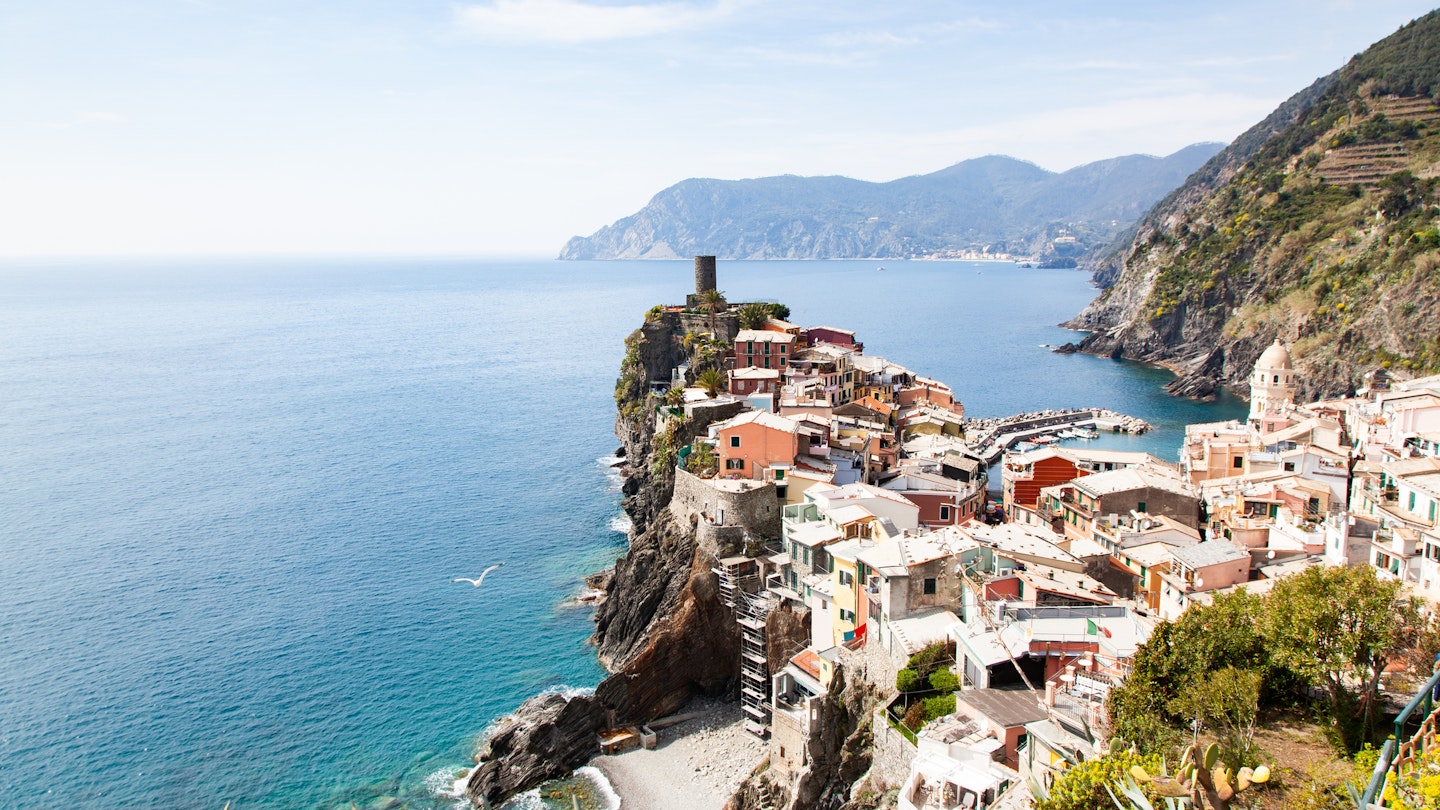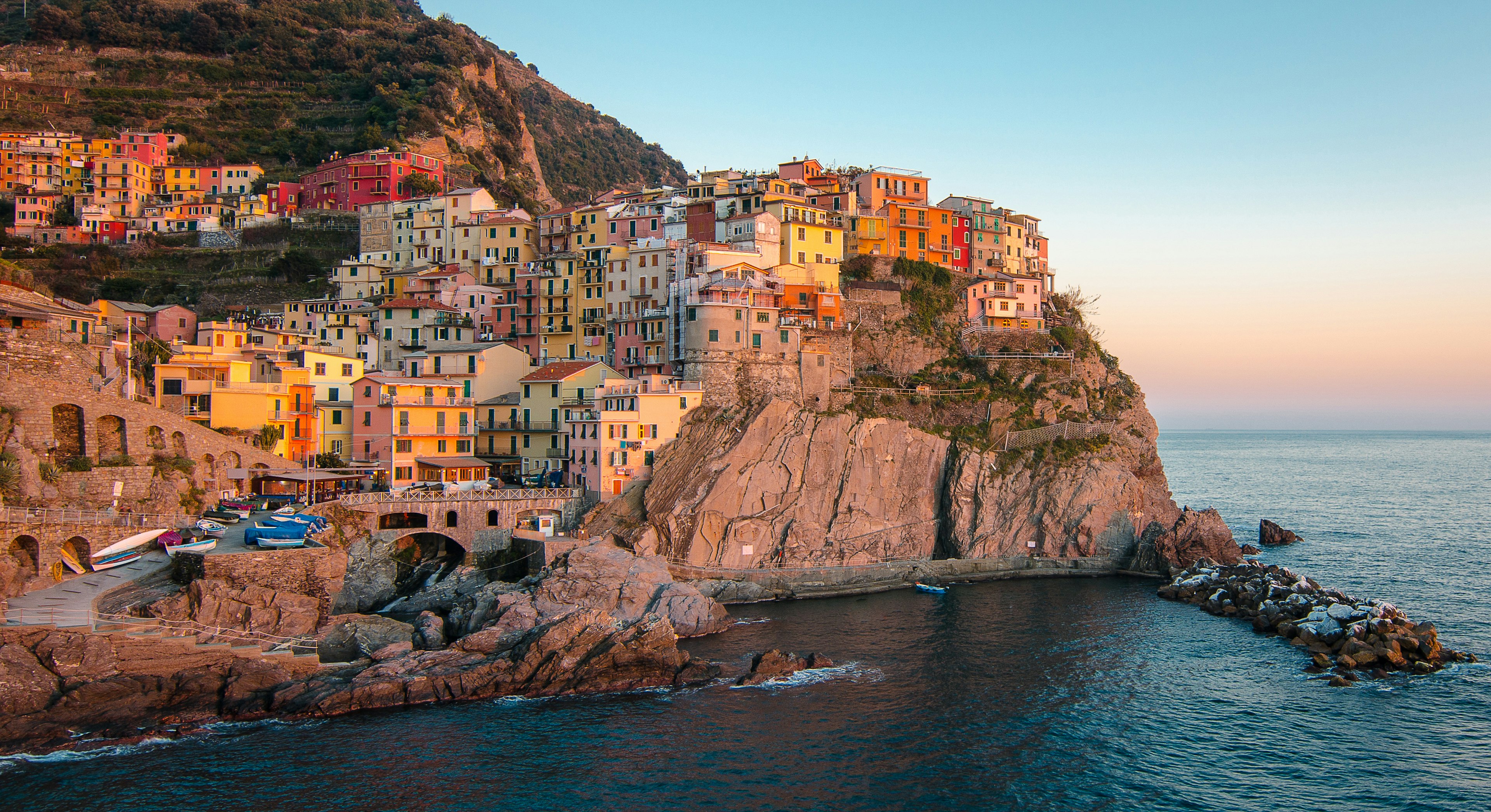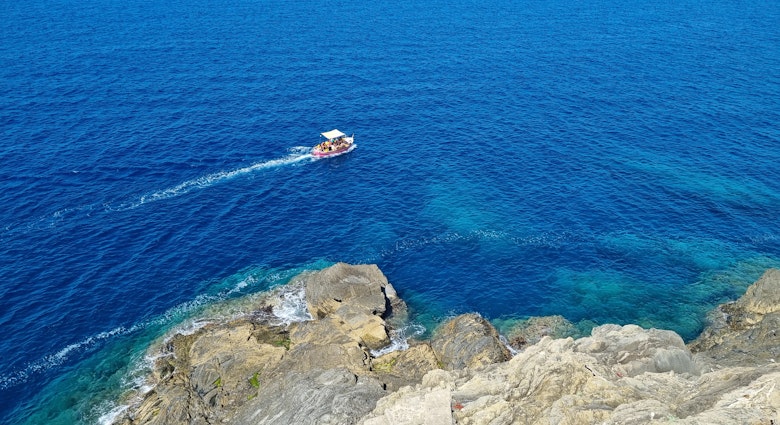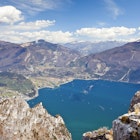

The Cinque Terre villages are unforgettable – here's how to build a perfect first trip © melis82 / Getty Images
So pretty that it inspired a Disney movie (Luca), Cinque Terre ("five lands") consists of five startlingly photogenic fishing villages on Italy's northwest coast, their candy-colored houses stacked down the sides of ravines and on top of cliffs. With sea, great food and wine, jaw-dropping views and photo opportunities at every turn, this is everything people love about Italy.
Today, however, that beauty is also its curse – it's one of the most overtouristed parts of the Bel Paese, with thousands of daytrippers crowding into the narrow streets, eager to take a couple of quick shots for the 'Gram and then leave. Is Cinque Terre overcrowded? Absolutely. Does that limit your enjoyment? Not if you take your time. Most people day-trip around the five villages, but stay longer – even three or four days – and you'll get a real appreciation of this extraordinary landscape.
One of the most remote parts of Italy – the single road arrived in the 1960s, and the railway a century earlier – Cinque Terre has always been a place of visceral beauty. Look up beyond those colored houses: for over 1,000 years, the residents have terraced the cliff sides and cultivated olives and wine that were once the toast of Europe's top tables.
Today, the entire area is a national park that celebrates human ingenuity as well as Mother Nature, with around 120km (75mi) of footpaths allowing you to explore it in the raw. But as well as a place to walk, this is also a place to relax. Watch the waves beat against the rocks from one of the medieval castles scattered along the coast – a hallmark of Liguria, the wider region. Drink a glass of wine cultivated on those very cliffs. Watch the sunset set the sea aflame. And rejoice that you chose more than a day trip.
This guide to Cinque Terre shows you how to make the best of your trip to this bucket-list Italian destination.
Want more Italian seaside fun? Head to these beautiful beaches
Introducing Cinque Terre's five villages
Riomaggiore
Vibes: The southernmost village packs fine-dining restaurants and good bars into its teeny terraces. If you're wondering where to start in Cinque Terre, this is your best bet.
See: Castello di Riomaggiore, the clifftop castle overlooking the village
Eat: In the mornings or for lunch on the run, grab a pastry or piece of focaccia at Panificio Rosi. The best views in town are from A Pié de Ma, a superb wine bar and restaurant on the cliffs that has an unbeatable selection of local wines by the glass. Run by Sicilian brothers, La Lampara is a superb seafood restaurant.
Stay: Locanda Ca da Iride has simple, comfortable rooms (but no breakfast) in the higher part of the village.

Manarola
Vibes: Arguably the prettiest part of Cinque Terre, cutesy Manarola has cottages stacked up and over the cliffs, as well as the area's loveliest main street, which spirals down a canyon to the water's edge.
See: Take the footpath forking upwards from the north side of the village to find yourself immersed in cliffside vineyards with spectacular sea views.
Eat: From breakfast to late lunches, Cappun Magru is the place for exceptional sandwiches, pastries and cakes, all washed down with local wine. You can't beat Nessun Dorma for an aperitivo with a view – it's jammed onto the cliffside and delivers sunset views. Da Aristide is a lovely family-run restaurant in the heart of the village. Try the muscoli ripieni – mussels stuffed with mortadella, parmesan and egg by nonna Grazia.
Stay: Posidonia is a sweet guesthouse with wonderful owners in the quiet, higher part of the village.
Corniglia
Vibes: Tiny Corniglia, perched high above the seas, is the only clifftop village in the region. From up here, you can see all of Cinque Terre.
See: Take in the views as you climb (or, easier, descend) the 383 steps between the sea-level train station and the village.
Eat: Dai Luca offers panini, foccacia and street food for snacks or meals on the run, while the wine bar Terra Rossa has a lovely selection of local dishes and drinks overlooking a pretty garden. A Cantina de Mananan is a lovely osteria (cafe) in the village serving the best Cinque Terre ingredients.
Stay: Il Carugio di Corniglia has rooms and apartments overlooking the sea.

Vernazza
Vibes: The busiest village, Vernazza was the most important in the past – though it's crowded, head up the steep staircases to quiet medieval alleyways – as twisty and atmospheric as the caruggi of regional capital Genoa.
See: Wander round the small harbor and step into the atmospheric 13th-century church of Santa Margherita d'Antiochia.
Eat: Top breakfast spot Il Pirata delle Cinque Terre has Sicilian granita and pastries in the morning, as well as excellent lunch and dinner. Grab a snack or pasta box at Pippo a Vernazza and wash it down with a wine tasting at nearby Cantina Cheo. Ristorante La Torre has spectacular views of the sea (though it's a hike to get there).
Stay: Restaurant Gianni Franzi also has rooms scattered throughout the village, most of which have spectacular sea views.
Monterosso al Mare
Vibes: With its long, sandy beach, this – usually known as plain "Monterosso" – is the largest village and the one that most resembles a regular beach resort.
See: Wander through the warren of the old town and head up to the humbug-striped Convento dei Cappuccini to see a Crucifixion by Van Dyck.
Eat: Start the day with pastries from Pasticceria Laura; to go all out, try the torta monterossina, stuffed with jam and chocolate. You could spend a whole day at Buranco – an agriturismo, vineyard and restaurant just outside the center. Take a bottle for a wander round the vineyard, then settle down to a superb home-cooked lunch. Local legend Miky Ristorante has been a must-visit since 1980.
Stay: Friendly Hotel Marina is near Buranco, just outside the historic center of the village.

When should I go to Cinque Terre?
Like the rest of Liguria, Cinque Terre enjoys beautiful, not-too-hot summers. Unlike nearby resorts along the Italian Riviera, however, this isn't really somewhere to flop on a beach – not least because Monterosso has the only real beach, with sand and small pebbles. The other villages either have rocky coves, boulders doubling as diving boards or harbors to swim in. Since most visitors come for an active trip with plenty of hiking, spring and fall are a better bet. Crowded throughout the year – unbearably so in summer – the area is quieter in winter, though it's not always possible to hike due to the weather. Cross-reference your dates with Italian public holidays, as the villages can be impossibly busy with daytrippers.
Italian locals share their favorite places to avoid the crowds on vacation
How much time should I spend in Cinque Terre?
The vast majority of visitors come here for a day trip, and while it's possible to visit all five villages in a day, to do so is to completely miss the beauty of the area. Rather like Venice, Cinque Terre is so popular, and so crowded, that if you just have a quick glimpse, you're likely to end up disappointed.
Instead, you probably need at least three or four full days in Cinque Terre to get a true taste. That gives you time to see the villages, walk some of the Sentiero Azzurro paths, sit back with some of the local wine as you take in the views, and even visit some of the villages further up the cliff sides. Spend a week, and you can add lesser-known hikes and visit some of Italy's most spectacular vineyards. Even longer is better – I spent two weeks on my first trip and enjoyed every minute.

Is it easy to get into and around Cinque Terre?
This is a relatively tough-to-reach location, which makes it even more important to spend as long as you can here. The closest airports are Genoa and Pisa – both are around 1-2 hours by train from Cinque Terre, depending on connections.
One extremely important point: driving here is absolutely to be avoided. Parking is extremely limited, expensive, and usually a long, steep climb outside the villages (only residents are allowed to park inside). The narrow, clifftop roads can also be frightening for newcomers to the area – the Amalfi Coast has nothing on these lanes, and even as a seasoned Italian cliffside driver, one time in Cinque Terre was one time too many for me. Even if you already have a car on your trip, it's best parking outside Cinque Terre (try La Spezia or Levanto) and coming in on the train. You have my word on this.
The best way to travel between the villages is definitely by rail. Trains run around every 15-20 minutes throughout the day, stopping at each of the five villages – the journey time between each stop is only a couple of minutes. Tickets cost €5-10 per journey (even if you're just doing a two-minute hop) depending on the season, and it's often better value to buy a timed Cinque Terre Card, which allows unlimited train travel between Levanto and La Spezia (the cities north and south of the area). The card also includes hiking fees, as well as bus travel to the more remote villages. Proceeds go to the national park.
You can also get around by boat. Navigazione Golfo dei Poeti runs between La Spezia and Levanto, calling at all the villages. Golfo Paradiso has a line from Genoa. Services can be suspended in bad weather, however, and boarding with a lot of luggage can be tricky.
In the villages themselves, the only real option is walking – and they are steep. Those with mobility issues will certainly find it difficult. The centers of Corniglia and Vernazza are largely flat, as is the beach area of Monterosso. Manarola and Riomaggiore are trickier for anyone with mobility issues.
Top things to do in Cinque Terre
Hike (some of) the Sentiero Azzurro
The most famous of Cinque Terre's paths is the Sentiero Azzurro (Blue Trail), which links all five villages across the cliff sides (it's marked as SVA on maps). In recent years, it's been rare that you'll find it fully open – winter storm damage means that some long stretches are closed. The easiest stretch – which is actually more of a moderate level – is Corniglia to Vernazza (2.5 miles, with a steep downhill section at the end). To get updates on closures, check the national park website before you head out.
See the coastline from the sea
Take a boat with Navigazione Golfo dei Poeti to see Cinque Terre's extraordinary landscape from the sea. It gives you an idea of the remoteness of the place – there wasn't a road here until the 1960s – and of how the locals have sculpted terraces from the sheer cliffs, making an uninhabitable landscape productive. Docking at the villages' tiny harbors is a memorable experience, and you can go onwards to La Spezia or (my pick) Levanto.
Walk the Via dell'Amore
Cinque Terre's most famous walk has always been the Via dell'Amore – the flat, accessible, 1km (half-mile) path between Riomaggiore and Manarola. Closed since 2012 due to landslide damage, it's due to reopen in July 2024 for guided tours only. I got a sneak peek last year and was impressed – the tours explain the rich history of the area and make you look beyond those color-popping houses.
Taste the local wine
For centuries, Cinque Terre has been known for its wine: sea-flecked salty whites grown along the cliffs. Try it by the glass at bars like A Pié de Ma in Riomaggiore or Cappun Magru in Manarola – both of these offer wine flights and tastings.
My favorite thing to do in Cinque Terre
Time for more wine: for me, nothing tells you more about Cinque Terre than perching high up in the hills, hearing how the locals have produced bottles that, in the Renaissance period, were so famous that they graced the tables of kings and popes. Tilling those cliffsides is backbreaking manual work, and while the vineyards are a fraction of what they were, they're important for stabilizing the increasingly fragile landscape and warding off the effects of climate change.
The best – and most fun – way to understand this is with a vineyard tour. You'll catch me high up on the hills above Vernazza on a tour from Cheo – from the vineyards, there are jaw-dropper views of the village, castle and sea below. Don't forget to try the heavenly sweet sciacchetrà wine that Cinque Terre is famous for – that sea-salt breeze adds an incredible tang.
How much money do I need for Cinque Terre?
Cinque Terre is expensive by Italian standards – visit in the high season or on a weekend, and you can expect to see prices double. Accommodation is particularly expensive in relation to the quality of what's on offer – there are very few hotels here, and usually your best bet is an affittacamere – room rental without breakfast. Accommodation in La Spezia or Levanto is usually cheaper and less problematic in terms of homeowners turfing out local renters to create Airbnbs, a major issue in the villages. Having said that, Cinque Terre's magic is especially strong at night.
You won't find any bargain restaurants or trattorias – prices are up there with high-end joints in major cities – but on the plus side, Liguria is the home of Italian street food, and there are plenty of small bakeries offering tasty snacks like focaccia that are good for lunch.
Average daily cost for:
Hostel room €20-40 (dorm spot)
Basic room for two €130-250
Self-catering apartment (including Airbnb) €150-250
Public transport ticket €5-10
Coffee €1-4
Sandwich €6-12
Dinner for two €60-150
Glass of Cinque Terre wine €6-15

Bring layers, no matter the season
Weather changes fast on the Liguria coast, and even in the hottest summer months, you'll probably need a jacket or sweater at night – as well as if you go out on a boat during the day.
Be prepared to walk… a lot
Don't underestimate how challenging the villages can be for those with mobility problems. Even if you're not planning to hike, Manarola and Riomaggiore are extremely steep. Be aware of that when you book your accommodation, too – there are limited porter services, and you should be prepared to cart your luggage up the cliffside.
Buy a Cinque Terre card
Village hop without counting the cost. The card includes access to all the hiking trails and allows you onto the bus routes to villages higher up on the cliffs. The proceeds go to the national park.
If availability is limited in the villages, stay in Levanto or La Spezia
Levanto and La Spezia bookend Cinque Terre and are included in Cinque Terre train tickets, so if you're booking last minute and the villages are sold out, try here (I prefer Levanto – La Spezia is a bigger city).
Support local businesses
Like all overtouristed areas, Cinque Terre's future depends on how tourists treat it. Shop at local artisan shops for souvenirs and eat at restaurants that utilize local products like marinated anchovies and regional wine. The latter is an important one – young locals replanting vineyards are helping to stabilize the fragile cliff terraces.
Take care on the trails
Cinque Terre's footpaths are so famous that you can often feel cushioned against nature, but these are vertiginous, cliffside trails that at times are lethally narrow. Always stop to take a photo, rather than walking with your camera, to avoid missteps. Wear decent shoes (flip flops are banned and there are checks at the trailheads) and bring plenty of water, as there's very little shade. Always stick to the designated path – this is an exceptionally fragile environment. And, of course, don't litter.
Explore related stories




 BeachesUltimate travel list: Lonely Planet's top sights in the world (21 to 30)
BeachesUltimate travel list: Lonely Planet's top sights in the world (21 to 30)Aug 17, 2015 • 6 min read






